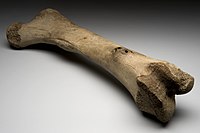
Photo from wikipedia
C terminus of Hsc70‐interacting protein (CHIP) is a chaperone‐dependent and U‐box containing E3 ubiquitin ligase. In previous studies, we found that CHIP regulates the stability of multiple tumor necrosis factor… Click to show full abstract
C terminus of Hsc70‐interacting protein (CHIP) is a chaperone‐dependent and U‐box containing E3 ubiquitin ligase. In previous studies, we found that CHIP regulates the stability of multiple tumor necrosis factor receptor‐associated factor proteins in bone cells. In Chip global knockout (KO) mice, nuclear factor‐κB signaling is activated, osteoclast formation is increased, osteoblast differentiation is inhibited, and bone mass is decreased in postnatal Chip KO mice. To determine the role of Chip in different cell types at different developmental stages, we created Chipflox/flox mice. We then generated Chip conditional KO mice ChipCMV and ChipOsxER and demonstrated defects in skeletal development and postnatal bone growth in Chip conditional KO mice. Our findings indicate that Chip conditional KO mice could serve as a critical reagent for further investigations of functions of CHIP in bone cells and in other cell types.
Journal Title: Journal of Cellular Physiology
Year Published: 2020
Link to full text (if available)
Share on Social Media: Sign Up to like & get
recommendations!